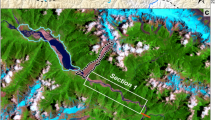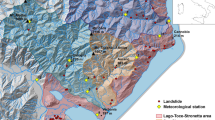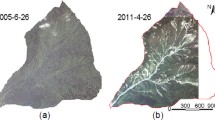Abstract
Gully sidewall expansion is an important geomorphic natural hazard, and the expansion destroys a large extent of agricultural land in the loess regions every year. The main aim of this study was to identify the mechanisms behind gully sidewall expansion through a series of simulated rainfall experiments. The results show that land loss on the gentle slope was the result caused by the water and gravity erosions, and gravity erosion was the primary driving force. The correlation coefficient between the area of land loss on gentle slope and volume of gravity erosion on the gully sidewall was 0.93, and the correlation coefficient between the area of land loss on gentle slope and volume of water erosion was 0.71. The gravity erosion was the dominant impetus driving the change in slope gradient of the gully sidewall. The amount of gravity erosion in 17 of the 19 rainfall events causing a change greater than 5° in the slope gradient of the gully sidewall accounted for more than 50% of the total amount of sidewall erosion. Furthermore, the dynamic variation of the retreat rates for the gully shoulder line showed a similar trend to that of the total volume of sidewall erosion and exhibited an increase–decrease–increase tendency. The most significant factors affecting the change in slope gradient of the gully sidewall and retreat rate of the gully shoulder line were the rainfall duration and intensity, of which the sensitivity coefficients were 2.2 and 4.0, respectively. As a result, a combination of vegetation measures on the gentle slope, structural and ecological practices on the sidewall and powerful structural practices, e.g., check dams, on the gully floor, is preferred for sidewalls vulnerable to expansion.










Similar content being viewed by others
Data availability
All data included in this study are available upon request by contacting the corresponding author.
References
Ali A, Huang J, Lyamin AV, Sloan SW, Cassidy MJ (2014) Boundary effects of rainfall induced landslides. Comput Geotech 61:341–354. https://doi.org/10.1016/j.compgeo.2014.05.019
Assouline S, Ben-Hur M (2006) Effects of rainfall intensity and slope gradient on the dynamics of interrill erosion during soil surface sealing. Catena 66:211–220. https://doi.org/10.1016/j.catena.2006.02.005
Blong RJ, Graham OP, Veness JA (1982) The role of sidewall processes in gully development; some NSW examples. Earth Surf Proc Land 7(4):381–385. https://doi.org/10.1002/esp.3290070409
Bochet E, Poesen J, Rubio JL (2006) Runoff and soil loss under individual plants of a semi-arid Mediterranean shrubland: influence of plant morphology and rainfall intensity. Earth Surf Proc Land 31(5):536–549. https://doi.org/10.1002/esp.1351
Chaplot V (2013) Impact of terrain attributes, parent material and soil types on gully erosion. Geomorphology 186:1–11. https://doi.org/10.1016/j.geomorph.2012.10.031
Chaplot V, Brown J, Dlamini P, Eustice T, Janeau JL, Jewitt G, Lorentz S, Martin L, Nontokozo-Mchunu C, Oakes E, Podwojewski P, Revil D, Rumpel C, Zondi N (2011) Rainfall simulation to identify the storm-scale mechanisms of gully bank retreat. Agr Water Manage 98(11):1704–1710. https://doi.org/10.1016/j.agwat.2010.05.016
Chen H, Cai QG (2006) Impact of hillslope vegetation restoration on gully erosion induced sediment yield. Sci China Ser D 49(2):176–192. https://doi.org/10.1007/s11430-005-0177-4
Chirico GB, Borga M, Tarolli P, Rigon R, Preti F (2013) Role of vegetation on slope stability under transient unsaturated conditions. Procedia Environ Sci 19:932–941. https://doi.org/10.1016/j.proenv.2013.06.103
Chorley RJ (1964) Geography and analogue theory. Ann Assoc Am Geogr 54(1):127–137. https://doi.org/10.1111/j.1467-8306.1964.tb00478.x
Claessens L, Temme AJAM, Schoorl JM (2013) Mass-movement causes: changes in slope angle. In: Shroder J (Ed in Chief), Marston RA, Stoffel M (eds), Treatise on Geomorphology, vol. 7, Mountain and hillslope geomorphology. Academic Press, San Diego, pp. 212–216. https://doi.org/10.1016/B978-0-12-374739-6.00167-6
Demissie B, Eetvelde VV, Frankl A, Billi P, Asfaha TG, Haile M, Nyssen J (2020) Dynamics of ephemeral streams at the foot of degraded catchments in northern Ethiopia. Land Degrad Dev 31:591–606. https://doi.org/10.1002/ldr.3474
Frankl A, Nyssen J, Dapper MD, Haile M, Billi P, Munro RN, Deckers J, Poesen J (2011) Linking long-term gully and river channel dynamics to environmental change using repeat photography (northern Ethiopia). Geomorphology 129:238–251. https://doi.org/10.1016/j.geomorph.2011.02.018
Gao H, Xu XZ, Zhang HW, Jiang YZ, Zhao TQ (2020) How effective is vegetation in reducing gravity erosion on loess gully sidewall under intense rainfalls? Land Degrad Dev 23:157–166. https://doi.org/10.1002/ldr.3634
Guo WZ, Chen ZX, Wang WL, Gao WW, Zhao M (2019) Telling a different story: the promote role of vegetation in the initiation of shallow landslides during rainfall on the Chinese Loess Plateau. Geomorphology. https://doi.org/10.1016/j.geomorph.2019.106879
Ionita I, Fullen MA, Zgłobicki W, Poesen J (2015) Gully erosion as a natural and human-induced hazard. Nat Hazards 79(1):S1–S5. https://doi.org/10.1007/s11069-015-1935-z
Jiao JY, Wang WZ (2001) Non-uniformity of the spatial distribution of rainfall on the Loess Plateau. Hydrology 21(2):20–24 (in Chinese)
Kuhnert PM, Henderson AK, Bartley R, Herr A (2010) Incorporating uncertainty in gully erosion calculations using the random forests modelling approach. Environmetrics 21(5):493–509. https://doi.org/10.1002/env.999
Li Z, Zhang Y, Zhu QK, He YM, Yao WJ (2015) Assessment of bank gully development and vegetation coverage on the Chinese Loess Plateau. Geomorphology 228:462–469. https://doi.org/10.1016/j.geomorph.2014.10.005
Liu BZ, Wu FQ (1993) Gully erosion and its development on the loess plateau. J NW F Univ 8:7–15 (in Chinese)
Liu Q, Wang YQ, Zhang J, Chen YP (2013) Filling gullies to create farmland on the Loess Plateau. Environ Sci Technol 47:7589–7590. https://doi.org/10.1021/es402460r
Liu H, Deng QC, Zhang B, Li X, Wang L, Luo MX, Qin FC (2016) Influences of different surveying and map** methods on fractal characteristics of gully-head shoulder lines. Phys Geogr 37:1–22. https://doi.org/10.1016/10.1080/02723646.2016.1228131
Lohnes RA (1991) A method for estimating land loess associated with stream channel degradation. Eng Geol 31(2):115–130. https://doi.org/10.1016/0013-7952(91)90001-2
Lomtadze VD (1977) Regularities of development of gravitational processes and their prediction. B Eng Geol Environ 15(1):9–12. https://doi.org/10.1007/bf02592634
Lu N, Godt JW (2013) Hillslope Hydrology and Stability. Cambridge University Press, Cambridge, UK
Magri O, Mantovani M, Pasuto A, Soldati M (2008) Geomorphological investigation and monitoring of lateral spreading along the north-west coast of Malta. Geogr Fis Din Quat 31(2):171–180. https://doi.org/10.1130/2008.2436(17)
Martínez-Casasnovas JA, Ramos MC, Poesen J (2004) Assessment of sidewall erosion in large gullies using multi-temporal DEMs and logistic regression analysis. Geomorphology 58:305–321. https://doi.org/10.1016/j.geomorph.2003.08.005
Meng QM (ed) (1996) Soil and Water Conservation on the Loess Plateau. Water Resources Press of the Yellow River, Zhengzhou, China, pp 166–167 (in Chinese)
Moges A, Holden NM (2008) Estimating the rate and consequences of gully development, a case study of the Umbulo catchment in Southern Ethiopia. Land Degrad Dev 19:574–586. https://doi.org/10.1002/ldr.871
Nyssen J, Descheemaeker K, Haregeweyn N, Haile M, Deckers J, Poesen J (eds) (2007) Lessons learnt from 10 years research on soil erosion and soil and water conservation in Tigray. Tigray Livelihood Papers No. 7, Mekelle Zala-Daget Project, Mekelle University, K. U. Leuven, Relief Society of Tigray, Africa museum and Tigray Bureau of Agriculture and Rural Development, pp 50
Orense RP (2004) Slope failures triggered by heavy rainfall. Philippine Eng J 25:73–90
Pasuto A, Soldati M (2013) Lateral Spreading. In: Shroder J (Ed. in Chief), Marston RA, Stoffel M (eds), Treatise on Geomorphology, vol 7, Mountain and hillslope geomorphology. Academic Press, San Diego, pp 239–248. https://doi.org/10.1016/B978-0-12-374739-6.00173-1
Pei QT, Li HB, Liu YQ, Jiang JG (2013) Influence of slope gradient on distribution rule of geostress field in river valleys. Appl Mech Mater 404:365–370
Qin W, Zhu QK, Zhao LL, Qi GM (2010) Topographic characteristics of ephemeral gully erosion in loess hilly and gully region based on RS and GIS. Trans of the CSAE 26(6):58–64 (in Chinese)
Qin C, Zheng FL, Wells R, Xu X, Wang B, Zhong K (2018) A laboratory study of channel sidewall expansion in upland concentrated flows. Soil Tillage Res 178:22–31. https://doi.org/10.1016/j.still.2017.12.008
Rowland JC, Dietrich WE, Day G, Parker G (2009) Formation and maintenance of single-thread tie channels entering floodplain lakes: observations from three diverse river systems. J Geophys Res 114:F02013. https://doi.org/10.1029/2008JF001073
Sánchez-Canales M, López-Benito A, Acuña V, Ziv G, Hamel P, Chaplin-Krame R, Elorza FJ (2015) Sensitivity analysis of a sediment dynamics model applied in a Mediterranean river basin: global change and management implications. Sci Total Environ 502:602–610. https://doi.org/10.1016/j.scitotenv.2014.09.074
Simon A, Collison AJC (2002) Quantifying the mechanical and hydrologic effects of riparian vegetation on streambank stability. Earth Surf Proc Land 27(5):527–546. https://doi.org/10.1002/esp.325
Spalevic V, Nyssen J, Curovic M, Lenaerts T, Kerckhof A, Annys K, Van Den Branden J, Frankl A (2013) The impact of land use on soil erosion in the river basin Boljanska Rijeka in Montenegro. Proceedings “Agrosym 2013”, Keynote Papers, pp 54–63. http://dx.doi.org/https://doi.org/10.7251/AGSY 1303054S
Tang GA, Zhao MD, Li TW, Liu YM, **e YL (2003) Modelling slope uncertainty derived from DEMs in loess plateau. Acta Geographica Sinica 58(6):824–830 (in Chinese)
Thornes JB, Alcantara-Ayala I (1998) Modeling mass failure in a Mediterranean mountain environment: climatic, geological, topographical and erosional controls. Geomorphology 24:87–100. https://doi.org/10.1016/S0169-555X(97)00103-7
Tu XB, Kwong AKL, Dai FC, Tham LG, Min H (2009) Field monitoring of rainfall infiltration in a loess slope and analysis of failure mechanism of rainfall-induced landslides. Eng Geol 105(1–2):134–150. https://doi.org/10.1016/j.enggeo.2008.11.011
Veness JA (1980) The role of fluting in gully extension. J Soil Conserv Serv N S W 36:100–108
Vianello A, Cavalli M, Tarolli P (2009) Lidar-derived slopes for headwater channel network analysis. Catena 76:97–106. https://doi.org/10.1016/j.catena.2008.09.012
Wang ZJ (2014) Characteristics of Vegetation and Erosion Sediment Yield in the Yanhe Watershed. Yangling: Research Center for Soil and Water Conservation and Ecological Environment, Chinese Academy of Sciences and Ministry of Education. (in Chinese)
Wang WZ, Jiao JY (1996) Statistic analysis of the variation of rainfall and runoff-sediment yield process on slope surface in Loess Plateau Region. B Soil Water Conserv 5:21–28 (in Chinese)
Wang C, Tang GA, Zhang T, Li ZB, Wang L, Wu LC (2005) The study with high precision and high resolution of spatial variation of slope at small loess watershed with the erosion of rainfall. J Mt Res 23:589–595 (in Chinese)
Wang LQ, Liang T, Zhang Q (2013) Laboratory experiments of phosphorus loss with surface runoff during simulated rainfall. Environ Earth Sci 70(6):2839–2846. https://doi.org/10.1007/s12665-013-2344-9
Wang ZJ, Jiao JY, Rayburg S, Wang QL, Su Y (2016) Soil erosion resistance of “Grain for green” vegetation types under extreme rainfall conditions on the Loess Plateau, China. Catena 141:109–116. https://doi.org/10.1016/j.catena.2016.02.025
Wang XF, Huo AD, Zhu XH, Zhao YB, Jiang C, Zheng XL (2019) Study on governance mode of gully consolidation and highland protection project in East Gansu. Yellow River 41:106–109 (in Chinese)
Wei W, Chen LD, Fu BJ, Lv YH, Gong J (2009) Responses of water erosion to rainfall extremes and vegetation types in a loess semiarid hilly area. NW China Hydrol Process 23(12):1780–1791. https://doi.org/10.1002/hyp.7294
Wijdenes DJO, Bryan RB (2001) Gully-head erosion processes on a semi-arid valley floor in Kenya: a case study into temporal variation and sediment budgeting. Earth Surf Process Landf 26(9):911–933. https://doi.org/10.1002/esp.225
Wu YQ, Zheng QH, Zhang YG, Liu BY, Chen H, Wang YZ (2008) Development of gullies and sediment production in the black soil region of northeastern China. Geomorphology 101:683–691. https://doi.org/10.1016/j.geomorph.2008.03.008
**ao CC, Tang GA (2007) Classification of valley shoulder line in loess relief. Arid Land Geogr 30(5):646–653 (in Chinese)
Xu XZ, Zhang HW, Zhang OY (2004) Development of check-dam systems in gullies on the Loess Plateau. China Environ Sci Policy 7(2):79–86. https://doi.org/10.1016/j.envsci.2003.12.002
Xu XZ, Liu ZY, **ao PQ, Guo WZ, Zhang HW, Zhao C, Yan Q (2015a) Gravity erosion on the steep loess slope: behavior, trigger and sensitivity. Catena 135:231–239. https://doi.org/10.1016/j.catena.2015.08.005
Xu XZ, Zhang HW, Wang WL, Zhao C, Yan Q (2015b) Quantitative monitoring of gravity erosion using a novel 3D surface measuring technique: validation and case study. Nat Hazards 75(2):1927–1939. https://doi.org/10.1007/s11069-014-1405-z
Xu XZ, Ma YL, Yang WJ, Zhang HW, Tarolli P, Jiang YZ, Yan Q (2020) Qualifying mass failures on loess gully sidewalls using laboratory experimentation. Catena 187:104252
Yan SJ, Tang GA, Li FY, Zhang L (2014) Snake model for the extraction of loess shoulder-line from DEMs. J Mt Sci 11(6):1552–1559. https://doi.org/10.1007/s11629-013-2484-0
Yang JS, Yao WY, Ma XP, Shao H, Wang LL (2011) Progress of the gravity erosion and sediment yield study in the Loess Plateau. Yellow River 33(9):77–79 (in Chinese)
Yitbarek TW, Belliethathan S, Stringer LC (2012) The onsite cost of gully erosion and cost-benefit of gully rehabilitation: a case study in Ethiopia. Land Degrad Dev 23:157–166. https://doi.org/10.1002/ldr.1065
Zgłobicki W, Baran-Zgłobicka B, Gawrysiak L, Telecka M (2015) The impact of permanent gullies on present-day land use and agriculture in loess areas (E. Poland). Catena 126:28–36. https://doi.org/10.1016/j.catena.2014.10.022
Zhang L, Tang GA, Li FY, **ong LY (2012) A review on research of loess shoulder-line. Geogr Geo Inf Sci 28(6):44–48 (in Chinese)
Zheng FL, **ao PQ (2010) Gully erosion and sediment yield on the Loess Plateau. Bei**g Science Press, pp 7 (in Chinese)
Acknowledgements
This study was supported by the National Key R & D Project (2016YFC0402504), National Natural Science Foundation of China (No. 51879032) and Open Research Fund Program of Key Laboratory of Process and Control of Soil Loss on the Loess Plateau (201903). Comments from two anonymous referees are greatly appreciated.
Author information
Authors and Affiliations
Contributions
Yulei Ma processed the data and composed the manuscript; **angzhou Xu designed and performed the experiments and processed the data; Peiqing **ao provided suggestions and reviewed the manuscript; Qiao Yan and Chao Zhao performed the experiments. All authors have read and approved the manuscript.
Corresponding author
Ethics declarations
Conflicts of interest
The authors declare no conflicts of interest.
Additional information
Publisher's Note
Springer Nature remains neutral with regard to jurisdictional claims in published maps and institutional affiliations.
Rights and permissions
About this article
Cite this article
Ma, Y., Xu, X., **ao, P. et al. Geomorphic natural hazard on loess terrain: expansion on the gully sidewall. Nat Hazards 109, 2535–2555 (2021). https://doi.org/10.1007/s11069-021-04931-2
Received:
Accepted:
Published:
Issue Date:
DOI: https://doi.org/10.1007/s11069-021-04931-2




